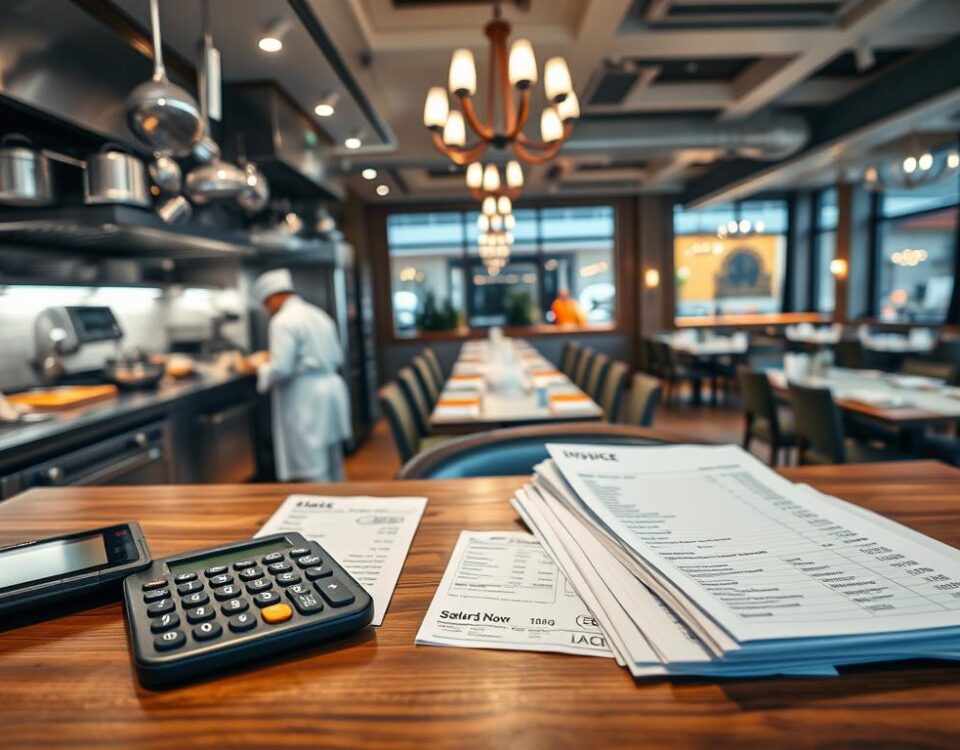
How to Cut Restaurant Insurance Premiums Without Losing Coverage
October 6, 2025
I Tried 7 Viral Restaurant Marketing Hacks—Here Are the Results
October 7, 2025As a restaurant owner, I’ve seen firsthand how a POS system can streamline operations, but I’ve also experienced the financial strain that comes with it. The reality is that many restaurants overspend on their POS systems, with some paying exorbitant credit card processing fees and monthly subscription costs.
Did you know that the average restaurant can save thousands of dollars annually by optimizing their POS system costs? With the right strategies, you can significantly reduce your expenses without sacrificing essential features or functionality. So, what’s the key to unlocking these savings?
By understanding the intricacies of your POS system and negotiating better rates with your provider, you can take control of your costs and boost your bottom line. In this article, I’ll share my insights on how to make your POS system work for you, not against you.
Key Takeaways
- Understand the various costs associated with your POS system to identify areas for reduction.
- Negotiate with your POS provider to secure better rates and terms.
- Optimize your payment processing options to save thousands annually.
- Evaluate your POS system’s features to ensure you’re not paying for unnecessary add-ons.
- Implement cost-saving strategies to maximize your POS system’s return on investment.
Understanding Restaurant POS System Costs
A thorough understanding of restaurant POS system costs helps owners avoid unexpected expenses and make better financial decisions. To achieve this, it’s essential to break down the various components that contribute to the overall cost.
Types of Restaurant POS Systems
There are three primary types of restaurant POS systems: cloud-based, on-premise, and hybrid. Cloud-based POS systems store data online and are accessible from any internet-connected device, typically having lower upfront costs but including monthly fees. In contrast, on-premise POS systems store data locally on servers within the restaurant, involving higher upfront costs for hardware and setup but no recurring subscription fees. Hybrid POS systems combine cloud and on-premise features, offering flexibility and local data control, generally with higher upfront costs but more customization options.
Average Cost Breakdown
The average cost of a restaurant POS system varies based on the type and size of the establishment. Costs include hardware expenses, software subscription fees, payment processing rates, and potential hidden costs. For instance, a small café might incur lower costs compared to a full-service restaurant with multiple stations. Understanding these cost structures is vital for selecting a POS system that aligns with the restaurant’s needs and budget.
By analyzing the cost ranges for different restaurant sizes and types, owners can make informed decisions. It’s also crucial to consider the long-term cost implications of different POS models and how they might impact the restaurant’s bottom line over time.
Hardware Cost-Saving Strategies
One of the most effective ways to lower POS system costs is by implementing hardware cost-saving strategies. By being mindful of the hardware components we choose, we can significantly reduce the overall cost of our POS system.
Choosing Essential Hardware Only
To save on hardware costs, it’s crucial to identify which components are truly essential for my restaurant type. For instance, a simple restaurant might only need a basic Touchscreen Terminal and a Receipt Printer, while a more complex establishment might require additional hardware like Handheld Ordering Devices or a Kitchen Display System (KDS). By distinguishing between necessary and nice-to-have extras, I can avoid unnecessary expenses. Hardware costs can range from $400 to $5,000, depending on the specific needs.

Exploring Refurbished Options
Exploring refurbished POS hardware can offer significant savings, often 30-50% off retail prices, while still providing reliable performance. Many refurbished devices are thoroughly inspected and repaired to meet manufacturer standards, making them a viable option for cost-conscious restaurants.
Leveraging BYOD (Bring Your Own Device) Solutions
Some POS systems allow me to use my own hardware, such as existing tablets or smartphones, as POS terminals. This BYOD (Bring Your Own Device) approach can potentially save hundreds or thousands in hardware costs. By leveraging what I already have, I can reduce the upfront costs associated with purchasing new hardware.
Reducing Software Subscription Fees
Reducing software subscription fees can greatly impact a restaurant’s bottom line. With POS software plans ranging from $0 to $400 per month, selecting the right subscription tier is crucial.
Selecting the Right Subscription Tier
To avoid paying for unused premium features, it’s essential to identify the subscription tier that matches your restaurant’s actual needs. Analyze your requirements and choose a plan that includes necessary features like inventory management and sales reporting without unnecessary extras.
Annual vs. Monthly Payment Plans
Comparing the cost savings of annual payment plans versus monthly subscriptions can help you save 10-20% on overall software costs. Consider committing to an annual plan if you can afford the upfront cost, as it can lead to significant savings.
Bundled Feature Packages
Bundled feature packages can offer better value than adding individual features à la carte. Evaluate your needs and look for packages that include the features you require, such as loyalty programs and third-party integrations. This approach can simplify your POS system and reduce costs.
By understanding your restaurant’s needs and exploring different pricing options, you can reduce your POS software fees. Consider negotiating custom subscription packages and testing POS software through free trials before committing to paid subscriptions.
How to Lower Restaurant POS System Fees Through Payment Processing
Restaurant owners can save thousands of dollars by understanding and reducing payment processing fees associated with their POS system. Payment processing fees are a significant ongoing cost for restaurants, and optimizing these fees can lead to substantial savings.

Understanding Payment Processing Fee Structures
There are several payment processing fee structures that restaurants should be aware of, including flat-rate pricing, interchange-plus pricing, tiered pricing, and per-transaction fees. Flat-rate pricing involves paying a fixed percentage per transaction, typically between 2.5% to 3.5%. Interchange-plus pricing offers more transparency by charging the card network’s “interchange” fee plus a markup from the processor.
Negotiating Better Processing Rates
Negotiating with payment processors can help restaurants secure better processing rates. By leveraging competition and understanding the fee structures, restaurants can reduce their processing rates by 0.5-1% per transaction. This can lead to significant savings over time, especially for high-volume restaurants.
Volume-Based Discounts
Many payment processors offer volume-based discounts for restaurants that process a high volume of transactions. By understanding these discounts and negotiating with processors, restaurants can qualify for reduced processing rates. This can be particularly beneficial for large or high-volume restaurants.
Minimizing Installation and Training Costs
Effective POS system implementation requires careful consideration of installation and training costs to avoid unexpected expenses. These costs can vary widely depending on the provider and the complexity of the system.
Self-Installation Options
Many modern POS systems are designed for easy self-installation, potentially saving hundreds in professional installation fees. I recommend exploring these options first, as they can significantly reduce upfront costs.
In-House Training Strategies
Developing in-house training programs can replace expensive vendor-provided training sessions. By adopting a “train-the-trainer” approach, where one or two staff members become system experts, you can efficiently train other staff members.
Free Resources and Tutorials
Utilizing free and low-cost resources such as online tutorials, user communities, and documentation can supplement formal training. These resources can help reduce training costs while ensuring your staff is proficient in using the POS system.
| Installation Type | Cost Range |
|---|---|
| On-site Installation | $500 – $2,000 |
| Remote Installation | $200 – $800 |
As noted by industry experts, “Investing in proper setup and training ensures effective use, which can enhance operational efficiency and customer service in the long run.”
“A well-implemented POS system is crucial for streamlining restaurant operations and improving customer satisfaction.”

Avoiding Hidden and Ongoing Costs
When implementing a POS system, it’s crucial to consider not just the initial costs, but also the ongoing expenses that can impact your bottom line. As a restaurant owner, understanding these costs can help you make informed decisions and avoid unexpected expenses.
Maintenance and Support Fee Optimization
Most POS systems require regular maintenance and updates to stay on track. To optimize these costs, I recommend selecting a service plan that includes troubleshooting and repairs. These plans can cost between $100 and $1,000 per year. By choosing the right plan, you can ensure that your POS system remains secure and up-to-date without overpaying for premium support you may not need.
Integration Fee Management
If you use third-party apps for online ordering or inventory management, you’ll likely face integration fees. These fees can range from $100 to $1,000, depending on the complexity of the integration. To manage these costs, consider choosing a POS system with an open API, which can simplify integrations and potentially reduce fees over time.

Data Security and Compliance Cost Reduction
Protecting customer data is a top priority, and complying with the Payment Card Industry Data Security Standard (PCI DSS) is essential. The cost of PCI compliance can vary from $100 to $1,500 annually, depending on the size of your business. To reduce these costs, consider implementing robust data security measures and exploring compliance solutions that fit your business needs.
By being aware of these potential costs and taking steps to manage them, you can minimize the total cost of ownership for your POS system and maximize your return on investment.
- Identify common hidden costs in POS contracts, such as maintenance fees and software updates.
- Optimize your support plan to get the level of assistance you need without overpaying.
- Manage integration fees by choosing a POS system with a flexible API.
- Reduce PCI compliance costs by implementing robust data security measures.
Negotiation Strategies for Better POS Deals
When it comes to POS systems, negotiation can make all the difference in maximizing ROI. To get the most value, it’s essential to employ effective negotiation strategies that can help lower costs and enhance the overall efficiency of your restaurant’s POS system.
Timing Your Negotiations
Timing is everything when negotiating POS deals. Scheduling negotiations at the end of sales quarters or fiscal years can lead to better deals as sales representatives work to meet their quotas. This strategic timing can result in more favorable pricing and terms.
Leveraging Competitor Quotes
Using competitor quotes as leverage is a powerful negotiation technique. By obtaining quotes from other POS providers, you can negotiate with your current or preferred provider to match or beat their pricing, potentially saving your restaurant significant costs.
Long-Term Contract Benefits and Pitfalls
Long-term contracts can offer locked-in rates, but they also limit flexibility. Weighing the benefits against the potential drawbacks is crucial. It’s also important to identify which contract terms are typically negotiable and to negotiate caps on annual price increases to protect against significant cost jumps over time.
| Negotiation Strategy | Benefits | Potential Drawbacks |
|---|---|---|
| Timing Negotiations | Better deals at end of sales quarters | Limited flexibility |
| Leveraging Competitor Quotes | Potential for lower pricing | Requires research and competitor quotes |
| Long-Term Contracts | Locked-in rates | Limited flexibility, potential for price increases |
Maximizing ROI from Your POS System
Your POS system is more than just a tool for transactions; it’s a key to unlocking business growth. By leveraging its advanced features, you can streamline operations, enhance customer experience, and ultimately boost profitability.
Utilizing Analytics to Boost Profits
Properly utilizing POS analytics can help identify your most profitable menu items, optimal pricing strategies, and peak business hours to maximize revenue. By analyzing sales data, you can make informed decisions to drive business growth.
Streamlining Operations with POS Features
POS inventory management features can reduce food waste and over-ordering, directly improving your bottom line. Additionally, labor management tools can optimize staffing levels based on sales patterns, reducing labor costs without sacrificing service.
Enhancing Customer Experience
Integrated loyalty programs can increase customer retention and visit frequency, providing a strong return on your POS investment. Tableside ordering and payment features can also increase table turnover rates and average check sizes, enhancing overall customer satisfaction.
| POS Feature | Benefit | Impact |
|---|---|---|
| Inventory Management | Reduces food waste and over-ordering | Improves bottom line |
| Labor Management | Optimizes staffing levels | Reduces labor costs |
| Loyalty Programs | Increases customer retention | Boosts sales |
By implementing these strategies, you can maximize the ROI from your POS system and drive business growth. Effective use of POS analytics, streamlined operations, and enhanced customer experience are key to achieving this goal.
Comparing Popular POS Systems for Cost Efficiency
To minimize POS system fees, it’s essential to evaluate and compare different POS options. When selecting a POS system, it’s crucial to consider not only the initial cost but also the ongoing fees and features that can impact your restaurant’s bottom line.
Toast POS Cost-Benefit Analysis
Toast POS offers customizable plans with a wide range of features, including digital menus, offline mode, and mobile payments. Its pricing starts at $0 for the basic plan, making it an attractive option for small restaurants. However, as your business grows, you may need to upgrade to paid tiers, which can increase costs.
Square POS Value Proposition
Square POS is another popular option, particularly for small restaurants and those with lower transaction volumes. Its free software and flat-rate processing make it an attractive choice. However, the hardware costs can add up, and the processing fees may be higher than other providers for high-volume businesses.
Other Cost-Effective POS Options
Other POS systems, such as TouchBistro, Clover, and Lightspeed, offer competitive pricing and features. TouchBistro starts at $69/month, while Clover begins at $179/month. A detailed comparison of these systems is essential to determine which one best suits your restaurant’s needs.
| POS System | Starting Price | Key Features |
|---|---|---|
| Toast POS | $0 | Digital menus, offline mode, mobile payments |
| Square POS | $0 (software) | Easy payment processing, user-friendly dashboard |
| TouchBistro | $69/month | Floor plan and table management, menu customization |
| Clover | $179/month | Flexibility with hardware options, employee scheduling |
By comparing these popular POS systems, you can make an informed decision and choose the most cost-effective solution for your restaurant.
Conclusion
In summary, a well-chosen POS system can help reduce expenses and boost your restaurant’s efficiency. To achieve this, I’ve outlined several key strategies for lowering restaurant POS system fees, from cost-saving hardware approaches to effective negotiation tactics.
Understanding the complete cost picture, including both obvious and hidden fees, is crucial before selecting a POS system. The right POS system, even if not the cheapest option, can provide significant ROI through operational efficiencies and increased sales.
To ensure you’re getting the best value, I recommend regularly reviewing your POS costs and renegotiating as your restaurant grows. By balancing cost-saving measures with the need for reliable features and support, you can optimize your POS system’s performance.
By implementing these strategies, you can achieve significant savings over time. Even small fee reductions can add up, making a substantial impact on your restaurant’s bottom line.
FAQ
What are the typical costs associated with a restaurant POS system?
The costs can vary, but on average, you can expect to pay between to 0 per month, depending on the provider and features.
How can I reduce my payment processing fees?
I can negotiate with my payment processor to secure better rates, consider using a flat-rate pricing model, or look into providers that offer volume-based discounts.
What are some cost-saving strategies for hardware costs?
I can consider buying refurbished hardware, leveraging BYOD (Bring Your Own Device) solutions, or purchasing only essential hardware to minimize upfront costs.
How can I optimize my software subscription fees?
I can select the right subscription tier for my business needs, consider annual payment plans, and look into bundled feature packages that offer more value at a lower cost.
What are some hidden costs associated with POS systems?
Some providers may charge extra for maintenance and support, integration, or data security and compliance, so it’s essential to carefully review the contract and ask about any potential additional costs.
How can I maximize ROI from my POS system?
I can utilize analytics to boost profits, streamline operations with POS features, and enhance customer experience to drive sales and loyalty.
What are some popular POS systems for cost efficiency?
Some cost-effective options include Toast POS, Square POS, and other providers that offer competitive pricing and valuable features.
Can I negotiate better deals with POS providers?
Yes, I can leverage competitor quotes, time my negotiations strategically, and consider long-term contracts to secure better pricing and terms.



